4.3: Dietary Guidelines
- Page ID
- 41760
Dietary Guidelines for Americans
The Dietary Guidelines are published and revised every five years jointly by the U.S. Department of Agriculture (USDA) and Health and Human Services (HHS) as a guide to healthy eating for Americans.
Purpose
The Dietary Guidelines are in place to give Americans, ages 2 and older, evidence-based information on what and how much to eat to stay healthy. These recommendations aim to:
- Promote health
- Prevent chronic disease
- Help people reach and maintain a healthy weight
Public health agencies, health care providers, and educational institutions all rely on Dietary Guidelines recommendations and strategies.3 These agencies use the Dietary Guidelines to:
- Form the basis of federal nutrition policy and programs such as WIC and SNAP
- Help guide local, state, and national health promotion and disease prevention initiatives
- Inform various organizations and industries (for example products developed and marketed by the food and beverage industry)
Process
Before HHS and the USDA release the new Dietary Guidelines, they assemble an Advisory Committee. This committee is comprised of nationally recognized nutrition and medical researchers, academics, and practitioners. The Advisory Committee develops an Advisory Report that synthesizes current scientific and medical evidence in nutrition, which will then advise the federal government in the development of the new edition of the Dietary Guidelines.
The public also has opportunities to get involved in the development of these guidelines. The Advisory Committee holds a series of public meetings for hearing oral comments from the public, and the public also has opportunities to provide written comments to the Advisory Committee throughout the course of its work. After the Advisory Report is complete, the public has opportunities to respond with written comments on health.gov/dietaryguidelines and provide oral testimony at a public meeting.
2020-2025 Dietary Guidelines for Americans
1. Follow a healthy dietary pattern at every life stage.
At every life stage—infancy, toddlerhood, childhood, adolescence, adulthood, pregnancy, lactation, and older adulthood—it is never too early or too late to eat healthfully.
- For about the first 6 months of life, exclusively feed infants human milk. Continue to feed infants human milk through at least the first year of life, and longer if desired. Feed infants iron-fortified infant formula during the first year of life when human milk is unavailable. Provide infants with supplemental vitamin D beginning soon after birth.
- At about 6 months, introduce infants to nutrient-dense complementary foods. Introduce infants to potentially allergenic foods along with other complementary foods. Encourage infants and toddlers to consume a variety of foods from all food groups. Include foods rich in iron and zinc, particularly for infants fed human milk.
- From 12 months through older adulthood, follow a healthy dietary pattern across the lifespan to meet nutrient needs, help achieve a healthy body weight, and reduce the risk of chronic disease.
2. Customize and enjoy nutrient-dense food and beverage choices to reflect personal preferences, cultural traditions, and budgetary considerations.
A healthy dietary pattern can benefit all individuals regardless of age, race, or ethnicity, or current health status. The Dietary Guidelines provides a framework intended to be customized to individual needs and preferences, as well as the foodways of the diverse cultures in the United States.
3. Focus on meeting food group needs with nutrient-dense foods and beverages, and stay within calorie limits.
An underlying premise of the Dietary Guidelines is that nutritional needs should be met primarily from foods and beverages—specifically, nutrient-dense foods and beverages. Nutrient-dense foods provide vitamins, minerals, and other health-promoting components and have no or little added sugars, saturated fat, and sodium. A healthy dietary pattern consists of nutrient-dense forms of foods and beverages across all food groups, in recommended amounts, and within calorie limits. The core elements that make up a healthy dietary pattern include:
- Vegetables of all types—dark green; red and orange; beans, peas, and lentils; starchy; and other vegetables
- Fruits, especially whole fruit
- Grains, at least half of which are whole grain
- Dairy, including fat-free or low-fat milk, yogurt, and cheese, and/or lactose-free versions and fortified soy beverages and yogurt as alternatives
- Protein foods, including lean meats, poultry, and eggs; seafood; beans, peas, and lentils; and nuts, seeds, and soy products
- Oils, including vegetable oils and oils in food, such as seafood and nuts
4. Limit foods and beverages higher in added sugars, saturated fat, and sodium, and limit alcoholic beverages.
At every life stage, meeting food group recommendations—even with nutrient-dense choices—requires most of a person’s daily calorie needs and sodium limits. A healthy dietary pattern doesn’t have much room for extra added sugars, saturated fat, or sodium—or for alcoholic beverages. A small amount of added sugars, saturated fat, or sodium can be added to nutrient-dense foods and beverages to help meet food group recommendations, but foods and beverages high in these components should be limited. Limits are:
- Added sugars—Less than 10 percent of calories per day starting at age 2. Avoid foods and beverages with added sugars for those younger than age 2.
- Saturated fat—Less than 10 percent of calories per day starting at age 2.
- Sodium—Less than 2,300 milligrams per day—and even less for children younger than age 14.
- Alcoholic beverages—Adults of legal drinking age can choose not to drink, or to drink in moderation by limiting intake to 2 drinks or less in a day for men and 1 drink or less in a day for women, when alcohol is consumed. Drinking less is better for health than drinking more. There are some adults who should not drink alcohol, such as women who are pregnant.

Many Americans fall below the EAR and AI for fiber, calcium, potassium, magnesium, choline, and vitamins A, D, E and C.1 One aim of the Dietary Guidelines is to help Americans increase their intake of foods that contain these key nutrients—vegetables, fruits, whole grains, and dairy.
The United States is not the only country that develops nutritional guidelines.
The Food and Agriculture Organization of the United Nations has a website where you can search for dietary guidelines for different countries, such as Sweden’s guidelines, illustrated below.

“ Sweden’s one-minute advice ” by Food and Agriculture Organization of the United Nations (FAO)
The Swedish National Food Agency also has a great resource, “Find Your Way To Eat Greener, Not Too Much and Be Active” on how to put these guidelines into practice.
One way the USDA and other federal agencies implement the Dietary Guidelines is through MyPlate, which we will discuss next.
MyPlate (USDA Food Guide)
For many years, the U.S. government has been encouraging Americans to develop healthful dietary habits. For example, the food pyramid was introduced in 1992 as the symbol of healthy eating patterns for all Americans.

In 2005, the food pyramid was replaced with MyPyramid.

MyPyramid, introduced in 2005.
However, many felt this new pyramid was difficult to understand, so in 2011, the pyramid was replaced with MyPlate.
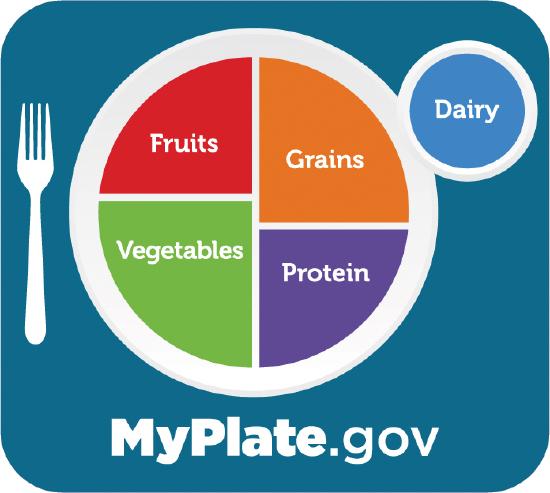
MyPlate is a food guide to help Americans achieve the goals of the Dietary Guidelines for Americans. For most people this means eating MORE:
- whole grains
- fruits
- vegetables (especially dark green vegetables and red and orange vegetables)
- legumes
- seafood (to replace some meals of meat and poultry)
- low-fat dairy
And LESS:
- refined grains
- added sugars
- solid fats: saturated fats, trans fats, and cholesterol
- sodium
Foods are grouped into 5 different groups based on their nutrient content. The following table summarizes the different food groups, examples of foods that fall within each group, and nutrients provided for each food group.
| Food Group | Examples of Foods | Nutrients Provided |
 |
Whole grains: brown rice, oats, whole wheat bread, cereal and pasta, popcorn Refined grains: typically tortillas, couscous, noodles, naan, pancakes (although sometimes these products can be whole grains too) For more foods and what counts as a cup check out: The Grain Group Food Gallery |
|
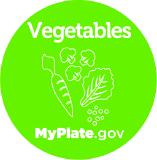 |
Dark green vegetables: broccoli, kale, and spinach Red and orange vegetables: bell peppers, carrots and tomatoes Starchy vegetables: corn, peas and potatoes Beans and Peas: hummus, lentils and black beans Other vegetables: asparagus, avocado, zucchini For more foods and what counts as a cup check out: The Vegetable Group Food Gallery |
|
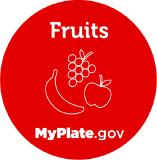 |
Fresh berries, melons, and other fruit as well as 100% fruit juice Fruits can also be canned, frozen, or dried, and may be whole, cut-up, or pureed For more foods and what counts as a cup check out: The Fruit Group Food Gallery |
|
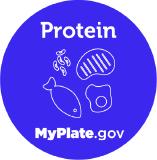 |
Meats, poultry, seafood, beans and peas, eggs, nuts and seeds For more foods and what counts as a cup check out: The Protein Group Food Gallery |
|
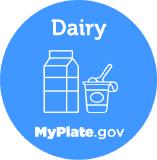 |
Milk, yogurt, cheese and calcium-fortified soy milk Foods such as cream cheese, cream, and butter, are not part of the Dairy Group as they have little/no calcium (they count as a fat) For more foods and what counts as a cup check out: The Dairy Group Food Gallery |
|
Table \(\PageIndex{1}\): A summary of MyPlate food groups, examples of foods that fall within each group, and nutrients provided for each food group. “MyPlate Summary” by Tamberly Powell is licensed under CC BY-NC-SA 4.0; information in the table is from ChooseMyPlate is in the Public Domain “Food Group Buttons” from the USDA is in the Public Domain
This graphic summarizes serving sizes for each of the food groups:
Planning a healthy diet using the MyPlate approach is not difficult:
- Fill half of your plate with a variety of fruits and vegetables, including red, orange, and dark green vegetables and fruits, such as kale, collard greens, tomatoes, sweet potatoes, broccoli, apples, oranges, grapes, bananas, blueberries, and strawberries in main and side dishes. Vary your choices to get the benefit of as many different vegetables and fruits as you can. One hundred percent fruit juice is also an acceptable choice as long as only half your fruit intake is replaced with juice.
- Fill a quarter of your plate with grains. Half of your daily grain intake should be whole grains such as 100 percent whole-grain cereals, breads, crackers, rice, and pasta. Read the ingredients list on food labels carefully to determine if a food is comprised of whole grains. We will discuss how to identify whole grains in more detail in later units.
- Select a variety of protein foods to improve nutrient intake and promote health benefits. Each week, be sure to include a nice array of protein sources in your diet, such as nuts, seeds, beans, legumes, poultry, soy, and seafood. The recommended consumption amount for seafood for adults is two 4-ounce servings per week. When choosing meat, select lean cuts.

- If you enjoy drinking milk or eating dairy products, such as cheese and yogurt, choose low-fat or nonfat products. Low-fat and nonfat products contain the same amount of calcium and other essential nutrients as whole-milk products, but with much less fat and calories. Calcium, an important mineral for your body, is also found in lactose-free dairy products and fortified plant-based beverages, like soy milk. You can also get calcium from vegetables and other fortified foods and beverages.
- Oils are also important in your diet as they contain valuable essential fatty acids. Oils like canola oil also contain more healthful unsaturated fats compared to solid fats like butter. You can also get oils from whole foods like fish, avocados, and unsalted nuts and seeds. Although oils are essential for health, they do contain about 120 calories per tablespoon, so moderation is important.
Some people have criticized the Dietary Guidelines for Americans and MyPlate for being influenced by political and economic interests, as the meat and dairy industries and large food companies have a powerful lobbying presence. Marion Nestle, author of the book, “Food Politics: How the Food Industry Influences Nutrition and Health,” gives her review of the guidelines and discusses a bit of the politics behind them in her blog post, “The 2015 Dietary Guidelines, at long last.”
Another guide for creating healthy, balanced meals comes from Harvard’s School of Public Health. The Healthy Eating Plate (HEP) is based on the best available science and is not influenced by political or commercial pressures from food industry lobbyists.

The message of the HEP is similar to MyPlate in that the focus is on diet quality—encouraging nutrient-dense whole grains, fruits, vegetables, and beans. However, there are a few key differences between MyPlate and HEP. For example, MyPlate recommends 3 cups of dairy a day, whereas HEP recommends limiting dairy to 1-2 cups per day, and instead encourages non-dairy sources of calcium like collards, bok choy, fortified soy milk, and baked beans.
The HEP encourages protein sources from fish, poultry, beans or nuts, and it encourages consumers to limit red meat and avoid processed meat (since these foods raise the risk of heart disease, diabetes, and colon cancer.)5 MyPlate does not mention that red and processed meat should be limited. Why not? According to Marion Nestle, “Politics, of course.”
Attributions:
- University of Hawai‘i at Mānoa Food Science and Human Nutrition Program, “Achieving a Healthy Diet,” CC BY-NC 4.0
- “Recommendations for Optimal Heath,” section 2.5 from the book An Introduction to Nutrition (v. 1.0), CC BY-NC-SA 3.0
References:
- 1US Department of Health and Human Services and U.S. Department of Agriculture. (2020). Dietary Guidelines for Americans. Retrieved from https://www.dietaryguidelines.gov/sites/default/files/2020-12/DGA_2020-2025_ExecutiveSummary_English.pdf
- 2Rumsey, A. (2018, Janurary 8) Why Eating Fewer Calories Won’t Help You Lose Weight. U.S. News. Retrieved from health.usnews.com/health-news/blogs/eat-run/articles/2018-01-08/why-eating-fewer-calories-wont-help-you-lose-weight
- 3Office of Disease Prevention and Health Promotion. (2019). About the Dietary Guidelines, Purpose. Retrieved from health.gov/dietaryguidelines/purpose.asp
- 4Office of Disease Prevention and Health Promotion. (2019). About the Dietary Guidelines, Process. Retrieved from health.gov/dietaryguidelines/process.asp
- 5Harvard’s School of Public Health, The Nutrition Source. (2019). Healthy Eating Plate vs. USDA’s MyPlate. Retrieved from https://www.hsph.harvard.edu/nutritionsource/healthy-eating-plate-vs-usda-myplate/


